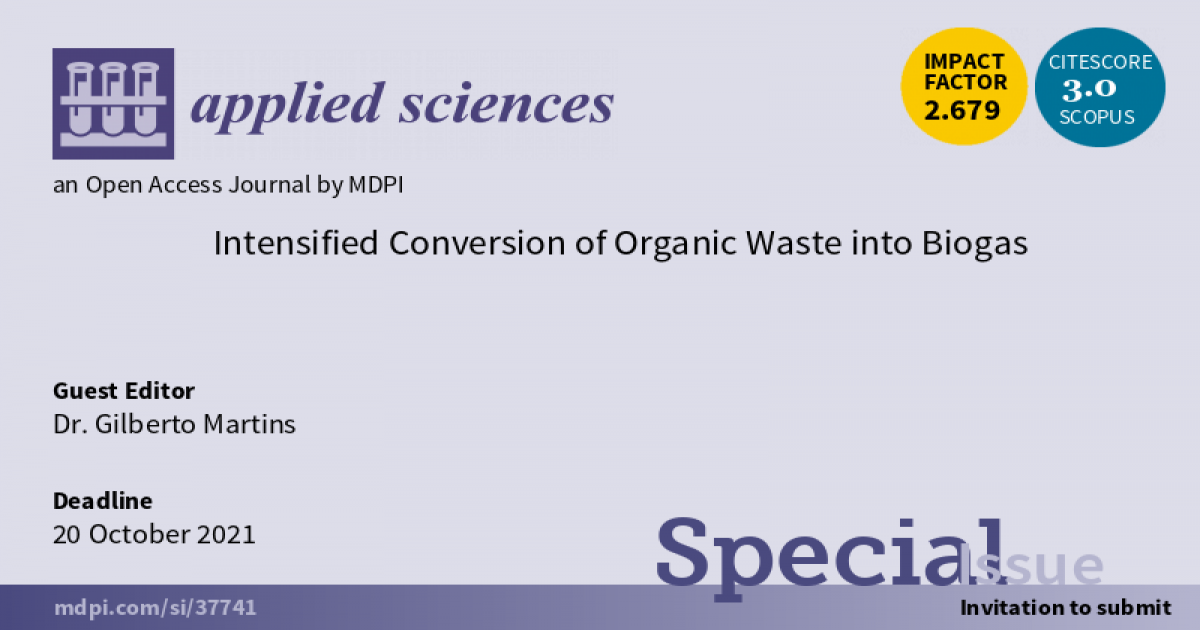Intensified Conversion of Organic Waste into Biogas
A special issue of Applied Sciences (ISSN 2076-3417). This special issue belongs to the section "Environmental Sciences".
Deadline for manuscript submissions: closed (20 October 2021) | Viewed by 36277

Special Issue Editor
Special Issue Information
Methane is a renewable energy source that can be produced in controlled bioengineered systems from a wide range of organic substrates. However, anaerobic digestion and, in particular, methanogenesis, has always been seen as a slow process.
Several strategies have been implemented to improve anaerobic digestion of organic waste. Empirical modification of process design, operational conditions, application of substrate pretreatments, and waste co-digestion are some examples. Recent advances in the field have shown that the addition of conductive materials to anaerobic digestion processes can improve methane production rates, reduce lag phases, apply higher organic loading rates, and contribute toward a more stable operation of the systems. Further, the performance of anaerobic digesters can be improved with bioelectrochemical systems by applying a fixed potential. These systems are able to reduce carbon dioxide to methane via direct and/or indirect extracellular electron transfer.
Therefore, the main goal of the present Special Issue is to contribute to the expansion of knowledge in this field, both promoting research focused on the use of conductive materials and/or bioelectrochemical systems in anaerobic systems, and to report the interactions between these systems and the involved microbial communities.
Dr. Gilberto Martins
Guest Editor
Manuscript Submission Information
Manuscripts should be submitted online at www.mdpi.com by registering and logging in to this website. Once you are registered, click here to go to the submission form. Manuscripts can be submitted until the deadline. All submissions that pass pre-check are peer-reviewed. Accepted papers will be published continuously in the journal (as soon as accepted) and will be listed together on the special issue website. Research articles, review articles as well as short communications are invited. For planned papers, a title and short abstract (about 250 words) can be sent to the Editorial Office for assessment.
Submitted manuscripts should not have been published previously, nor be under consideration for publication elsewhere (except conference proceedings papers). All manuscripts are thoroughly refereed through a single-blind peer-review process. A guide for authors and other relevant information for submission of manuscripts is available on the Instructions for Authors page. Applied Sciences is an international peer-reviewed open access semimonthly journal published by MDPI.
Please visit the Instructions for Authors page before submitting a manuscript. The Article Processing Charge (APC) for publication in this open access journal is 2400 CHF (Swiss Francs). Submitted papers should be well formatted and use good English. Authors may use MDPI's English editing service prior to publication or during author revisions.
Keywords
- Anaerobic digestion
- Methanogenesis
- Conductive materials
- Bioelectrochemical systems
- Direct interspecies electron transfer
- Hydrogen and formate electron transfer
- Syntrophic interactions
- Microbial community structure
Benefits of Publishing in a Special Issue
- Ease of navigation: Grouping papers by topic helps scholars navigate broad scope journals more efficiently.
- Greater discoverability: Special Issues support the reach and impact of scientific research. Articles in Special Issues are more discoverable and cited more frequently.
- Expansion of research network: Special Issues facilitate connections among authors, fostering scientific collaborations.
- External promotion: Articles in Special Issues are often promoted through the journal's social media, increasing their visibility.
- Reprint: MDPI Books provides the opportunity to republish successful Special Issues in book format, both online and in print.
Further information on MDPI's Special Issue policies can be found here.





